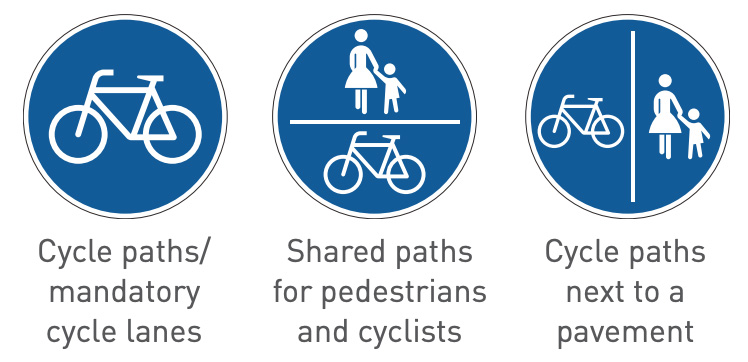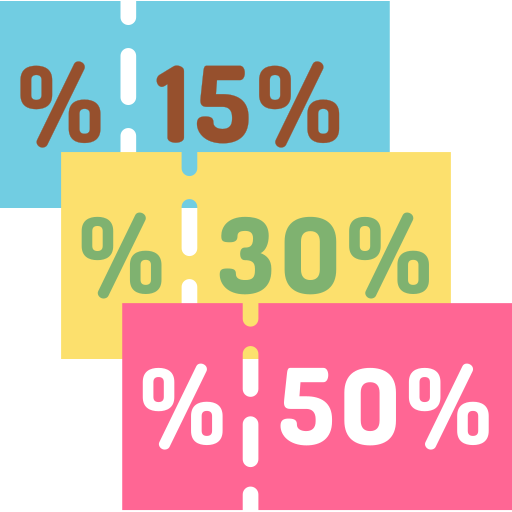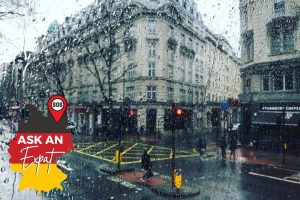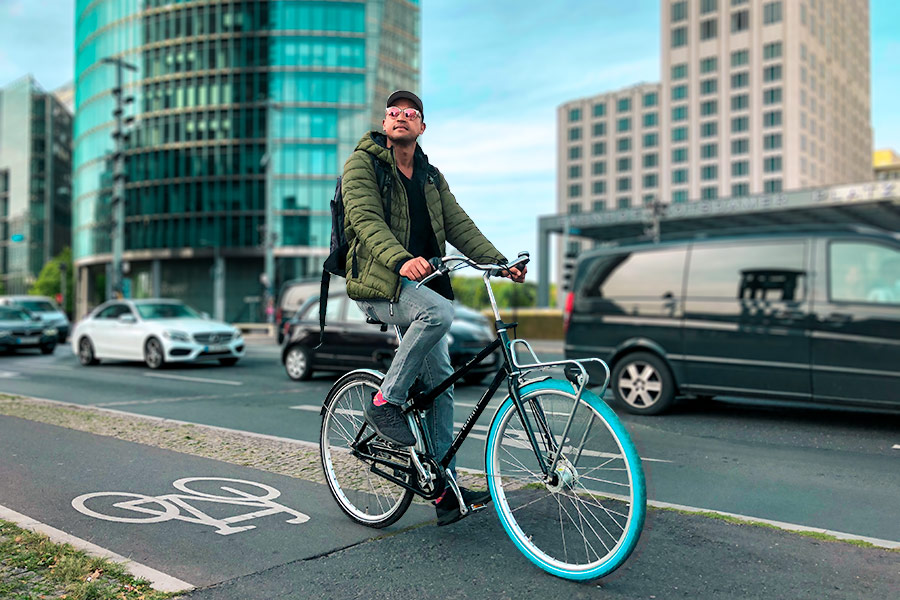
The essential bike road rules and traffic signs you should know before cycling in Germany. Find out how to safely (and legally) ride a bicycle in one of Europe’s most bike-friendly countries and avoid unnecessary traffic fines.
Cycling is one of the most popular ways to commute and get around in Germany. It’s often a faster way to get around the city, saves you money, great for your health and an eco-friendly way to travel.
While Germany is a bike-friendly country and it may be tempting to just hop on a bike and go, there is a list of essential German bike road rules and traffic laws you should know before cycling in Germany.
This comprehensive guide will cover everything you need to know to ride a bike safely (and legally) in Germany. From basic German rules and laws for cycling in Germany, the items you need for a bike to be considered roadworthy, to the most important bike road rules and German road signs for cyclists.
So whether you’re cycling in big cities like Berlin, Frankfurt, Hamburg, Stuttgart, Dusseldorf or Munich, or planning an epic bike tour in Germany’s beautiful countryside, you can do so confidently and safely with these tips and guidelines.
Note: Many of these cycling rules apply to riding electric scooters (e-scooters) in Germany too.
Basic Rules for Cycling in Germany
Before we jump straight into the what, where and how of bike road rules and traffic signs. There are a few basic German rules and laws you should know before cycling in Germany.
1. Bicycle Requirements For Cycling in Germany
There are certain items that you are legally required to have on your bike for your bicycle to be considered roadworthy for cycling in Germany.
These are:
- A white (or pale yellow) front light that is non-blinking;
- A red brake light at the rear of the bike that stays lit when you’re stationary;
- At least 2 yellow reflectors on each wheel or alternatively, the tires or spokes need to be reflective;
- A loud sounding bell;
- Two independently acting braking devices.
All these items need to be in good working condition for you to cycle safely (and legally) in Germany without risking a traffic fine.
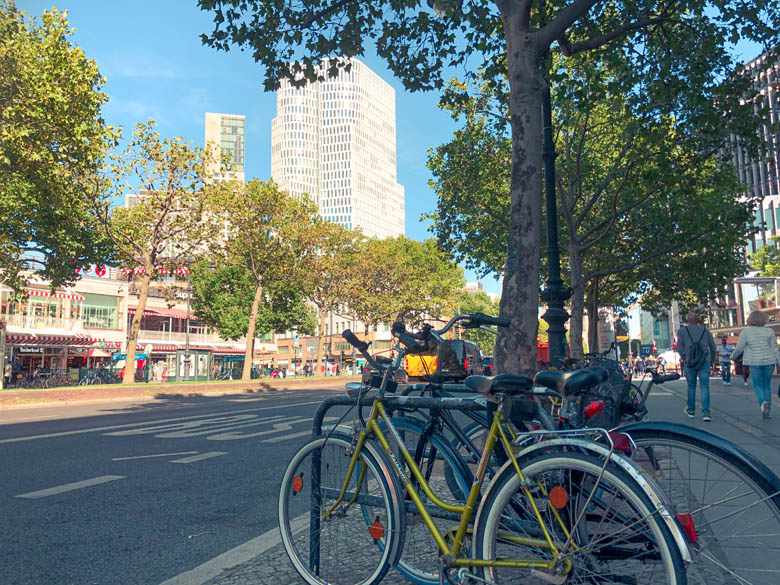
Traffic Fines for not meeting these bicycle requirements are:
- Brakes or bell not present or not working: €15
- Missing or broken bike light: €20
- Not switching on your lights when it’s dark, during poor visibility or the light is covered or too dirty: €20
Bike Sharing in Germany
This list may sound a little intimating if you’re new to the bike life and not familiar with bicycle equipment. So before investing in your own bike, we’d recommend cycling in Germany using bike sharing first.
All the bike sharing bicycles have the required items and equipment to be considered road worthy according to German traffic laws. This will also help you get used to riding a bike in Germany and get familiar with the bike road rules and traffic signs.
Not sure which bike sharing company in Germany to try? Don’t worry. Use our Berlin Bike Sharing guide to figure out how bike sharing works and which company offers the best value for money.
The prices may be slightly different depending on which city you’re cycling in Germany. But it will still give you a good idea on which bike sharing to use for short rides, day trips or even monthly bicycle rentals.
We personally bike share using Swapfiets. It costs us €19.50 a month to rent a high quality, 7- gear bicycle that we can use and keep as if it were our own. And the best part is that we never have to worry about repairs or maintenance, as Swapfiets takes care of it all. Find out all the pros and cons in our honest Swapfiets Review.
Want to try Swapfiets for yourself? Use the Swapfiets Discount Code and SAVE €7.50 on your Swapfiets subscription (Discount Code: BEN70328).
If this discount code doesn’t work, let us know and we’ll find you another one.
2. Only 1 Person Per Bike
We’re all familiar with the romantic movie scene where there are two people on a bicycle, both smiling gleefully as they cycle towards the sunset.
We’re sorry to burst the bubble, but that only happens in movies. If you try that in Germany, you’d probably get stopped by the police or ‘Ordungsamt’ (Order Department in English) and get a fine for violating traffic laws.
So stick to only one person per bicycle (unless you’ve got a tandem bike) when cycling in Germany.
If you’re cycling with children (younger than 7 years of age), you’ll need to install a child seat or special trailer to the bike to carry kids without risking your safety or a traffic fine.
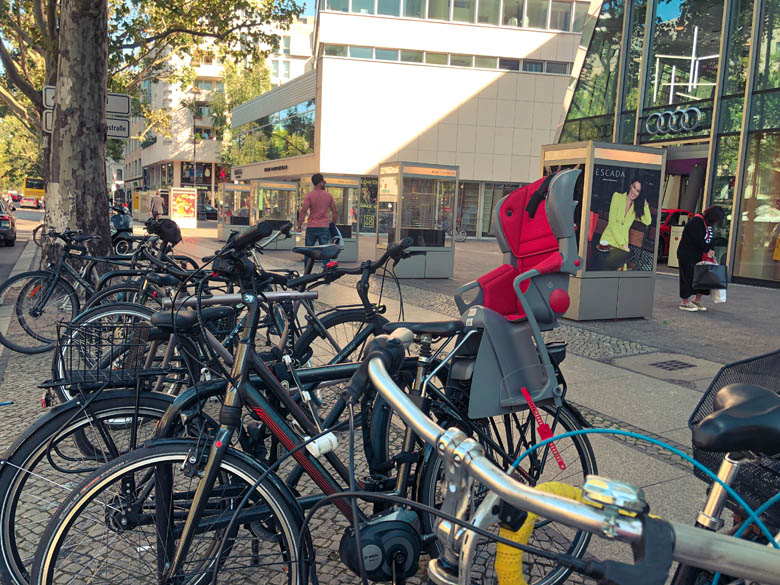
3. Bike Rules for Children Cycling in Germany
Germany is an incredibly bike-friendly country, even for kids! There are specific German laws and bike rules for children cycling in Germany.
Children up to the age of 8 years old are legally required to cycle on the pavement. And from 8 years up until the age of 10, kids can cycle in the bike lane or the pavement.
4. Keep Both Hands on the Handlebar
We’ve all envied that cool guy or girl confidently cycling hands-free. But don’t attempt this when cycling on the road or in the bike lane.
Always cycle with both hands on the handlebar. Otherwise, you could get a traffic fine for risking the safety of others and your own.
Reserve this nifty trick for bike-friendly outdoor parks like Tempelhofer Feld, where you can practice this skill to your heart’s content.
5. Bike Parking Rules
The rules for parking your bike is simple. You can practically park your bike anywhere in Germany as long as it doesn’t obstruct or endanger anyone and there are no signs prohibiting bikes from parking there.
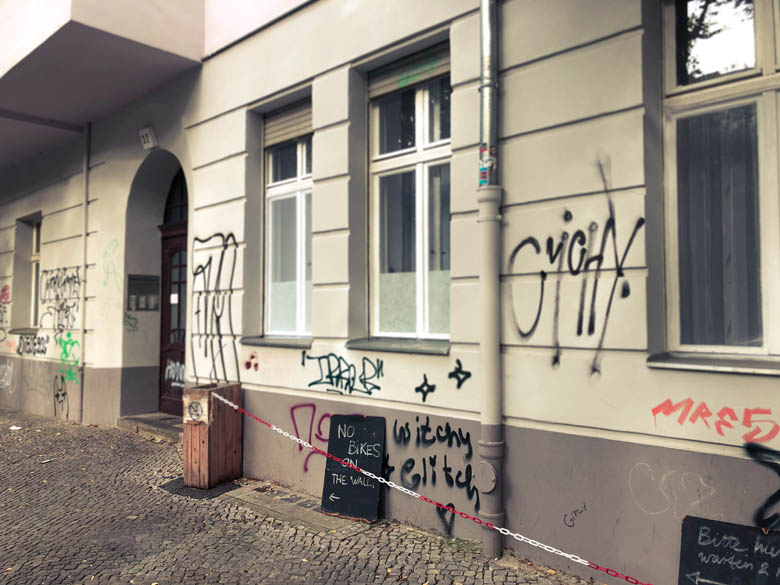
If in doubt, always park your bike at one of the many bicycle stands you’ll find around Germany. Not only will you save yourself from a potential €70 traffic fine (or a 1 point deduction from your driver’s licence) for causing an obstruction, you’ll also reduce the chances of someone stealing your bike.
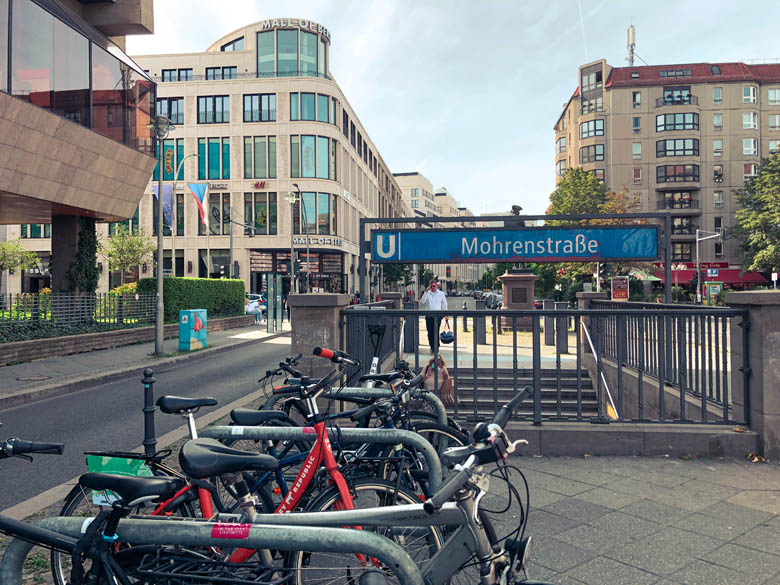
6. Helmet Laws Cycling in Germany
Is it illegal to ride a bike without a helmet in Germany? The short answer is no.
Germany has no official law that requires cyclists to wear bicycle helmets. It’s all up to the discretion of the cyclist.
Having said that, it’s highly recommended for your own safety to wear a cycling helmet whenever possible. This will significantly reduce the chance of serious head or brain injuries in the event you have an accident (touch wood).
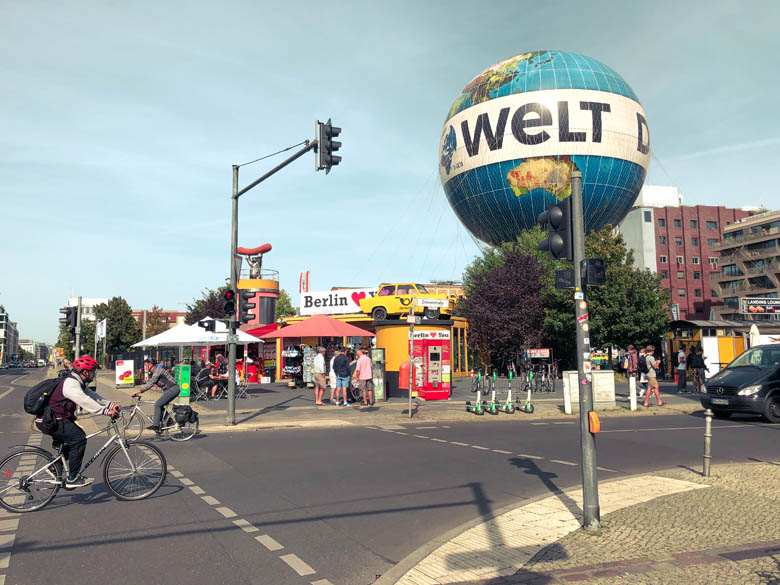
Related Guide: Ever lost your belongings whilst cycling? We have! Find out how you can recover your wallet, driving license, keys, phones, bags, residence permits, medical insurance cards, and much more in our Lost And Found Berlin guide.
7. Using Headphones When Cycling in Germany
The most frequently asked question when it comes to cycling in Germany: ‘Can you wear headphones and listen to music whilst cycling?’
We couldn’t find the exact German law on wearing headphones whilst cycling in Germany. But after reading tons of articles on the topic and asking around at bike shops, we’ve finally found the answer.
Yes, you are legally allowed to wear headphones when cycling in Germany. As long as you’re not playing music so loud that you can’t hear surrounding traffic.
If you’re still figuring out how to ride a bike in Germany, we’d recommend not wearing headphones at all. That way you can fully focus on cycling alone and be completely aware of your surroundings.
And if like us, you need GPS or Google Map directions, cycle with one earphone plugged in so you can still hear surrounding traffic.
Traffic Fine for limited hearing using headphones or other listening devices: €15
8. Cycling Whilst Walking Your Dog
Yes, you are allowed to simultaneously cycle and walk your dog on a leash as long as it doesn’t risk the safety of others, yourself or your dog’s.
9. Bike Insurance for Cycling in Germany
Personal liability insurance is one of the most important insurance you need to get if you’re living in Germany, especially if you bike regularly. It’s so essential that it ranks second after mandatory health insurance!
It’s particularly crucial to have if you’re cycling in Germany because personal liability insurance will cover you if you harm another person physically or damage their property in any way.
For cycling, that could mean accidentally hitting a pedestrian that was walking in the bike lane, to your parked bike falling over and damaging someone’s car.
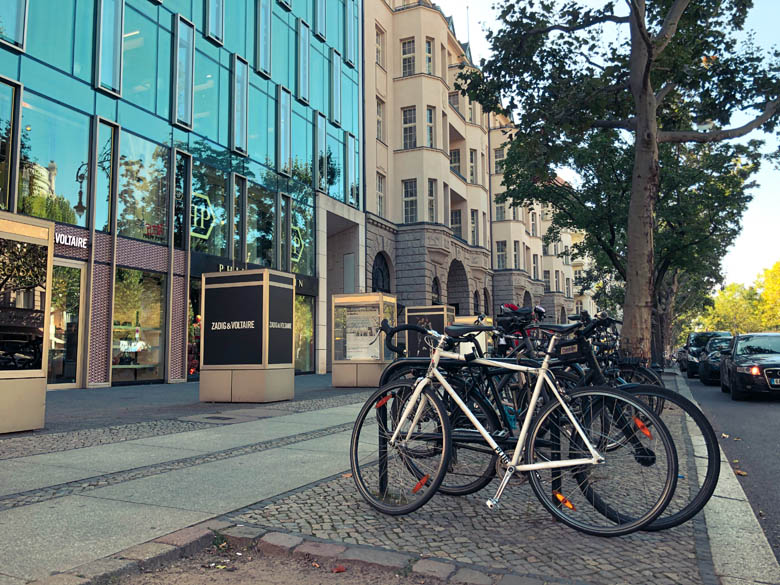
Damages could easily cost you several hundred thousands of Euros (and even into the millions) depending on the damage. So it’s really important that you get personal liability insurance whether you’re cycling in Germany or not.
The good news is that personal liability insurance in Germany is really affordable. You can sign up for it for as little as €4.99 per month and it will cover you for up to €30 million in damages.
The only problem for expats is that most of these insurers only offer German customer support. So if your German language skills isn’t quite up to scratch yet, you’ll struggle to understand the policy documents or speak to customer service.
But don’t you worry – we’ve got a solution for you! Get expat-friendly personal liability insurance in Germany with Feather Insurance to do it all in English. Use the code FEATHR15 to get a cashback bonus of €15 when you sign-up.
Bonus Tip: Did you know that more than 600,000 bikes are stolen in Germany EVERY year? This means that on average 1,640 bikes are stolen every, single day! Don’t become a statistic and make sure you get bike insurance in Germany. It costs as little as €2.90 per month!
Bike Road Rules For Cycling in Germany
Cyclists must comply to the rules of the road as you would normally do if you were driving a car. That means stopping at red traffic lights, stop signs and indicating before turning.
Those are obvious enough. But make sure you also follow these specific bike road rules when cycling in Germany.
10. Don’t Drink and Cycle
This is probably the most important bike rule in Germany. Never ride a bike in Germany when you’re under the influence of alcohol, drugs or medication.
You may think it’s harmless if you’re cycling at a snail’s pace. But if you’re stopped by the police for ‘suspicious cycling style’ and found guilty of being under the influence, it could lead to criminal charges.
If you’re having a night out, take your bike on the train or come collect it the next day. It’s not worth getting caught.
Traffic fine for drunk cycling or riding an e-scooter: You’ll get a fine if your alcohol level is over 0.3. If your alcohol level is over 1.6, you will be fined, get 3 points deducted from your driving license, AND ordered to take a medical psychological review (you have to pay for it). You could also risk having your driver’s license taken away for up to a year.
11. Don’t Use or Hold Your Phone Whilst Cycling
Another really important bike road rule is to never hold or use your phone whilst cycling. The police take this offence really seriously and will definitely stop you (and give you a fine) for this.
You also shouldn’t be making any calls whilst cycling, even if it’s hands-free because you’ll be less aware of surrounding traffic.
If you need your phone for directions, it’s worth investing in a quality bicycle cellphone holder so you don’t get in trouble with the law.
Traffic Fine for holding or using a mobile phone without hands-free kit whilst cycling: €55
Save Me For Later
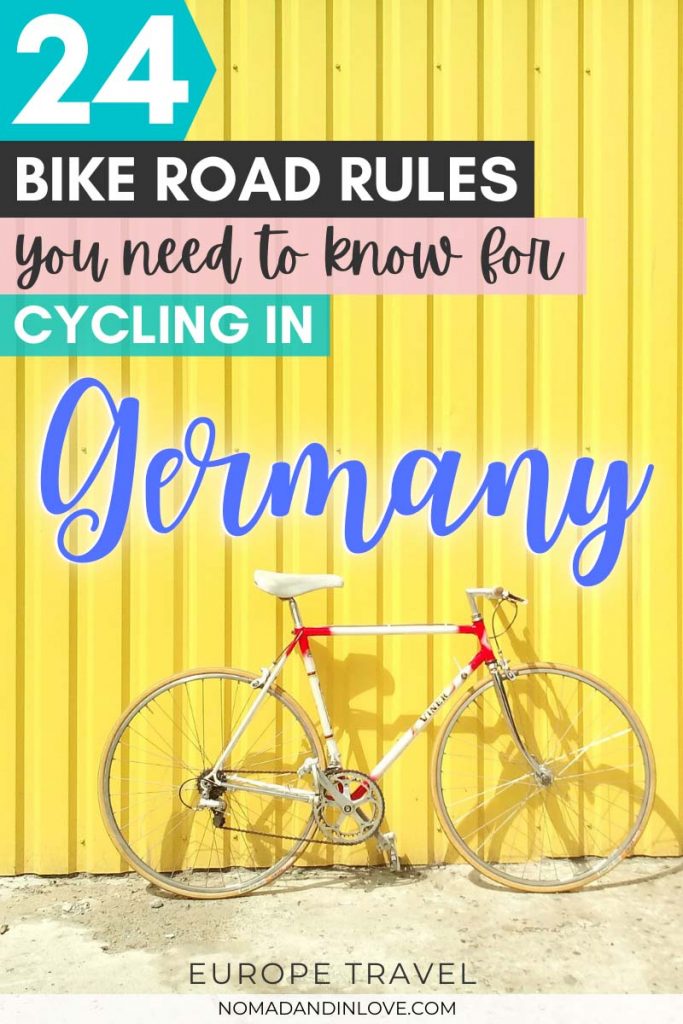
12. Cycle in the Bicycle Lane
We always recommend cycling in the bike lane when it’s available. Not only is it safer for you, but it’s also the best way to avoid annoying pedestrians or getting a fine.
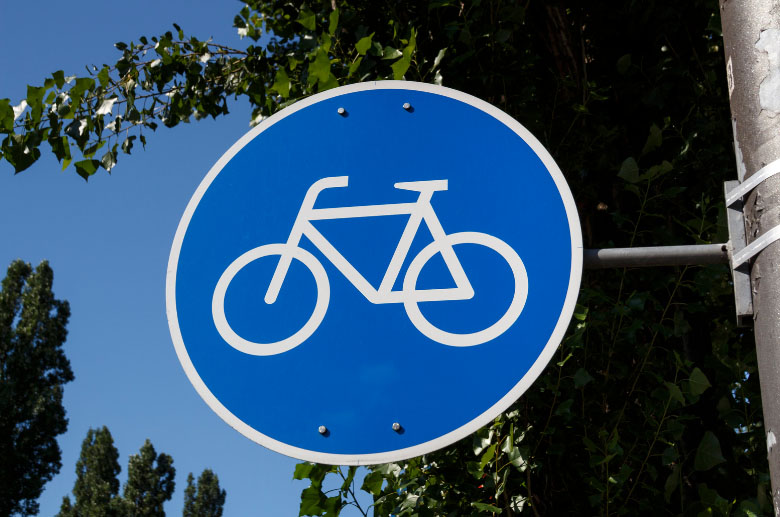
But if you see this blue traffic sign with a white bicycle on it. The bike road rule is that you must cycle on the dedicated bike lane unless there’s an obstruction. And if this sign is not shown, then you have the option to cycle on the road or the bike lane.
We’ll explain this in a lot more detail under the German Road Signs For Cycling section.
Traffic Fine for not cycling in a marked cycle path when the blue bicycle sign is shown: €20.
How do you tell if it’s a bike lane in Germany? Well, cycle paths are usually:
- Separated from the road by a kerb;
- An extension of the pavement but with a different colour and/or pattern of paving;
- On the road with markings and a painted bicycle diagram.
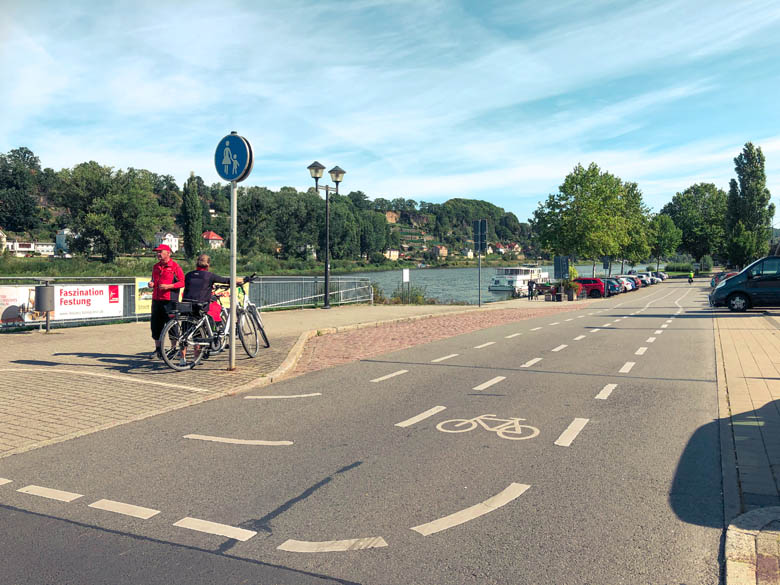
13. Keep To The Right
In Germany, you cycle on the right-hand side of the road, in the same direction as the cars to your left.
If no bicycle path is available, you can cycle in the street as close to the edge of the road as possible.
When cars are parked along the road, make sure you keep an arm’s lengths distance from parked vehicles. Just in case someone opens the door and unintentionally whacks you.
Traffic Fine for cycling in bicycle paths in the wrong direction: €20 (can be increased if someone else is endangered)
14. Cycle in Single File
Whether you’re cycling on dedicated bike lanes or on the road, you should always cycle in single file. This means that you should cycle one behind the other and not side by side.
The ‘keep to the right’ traffic rule applies in cycling lanes too. So keep to the right and only move to the left when overtaking.
The only time you’re allowed to ride a bike in Germany next to each other is down quiet streets where you won’t interfere with traffic. Otherwise, if you’re part of a group of 16 or more cyclists, you may also cycle side by side (maximum 2 per row).
Traffic Fine for cycling side by side with another person and causing problems for other road users: €20
15. Never Cycle on Highways or Motor Roads in Germany
This bike road rule is really important. You’re not allowed to cycle on highways or motor roads in Germany. This includes the autobahn, of course. It’s really dangerous for yourself and others.
If you’re planning to do long-distance cycling trips in Germany, always use the bike lanes next to the highway.
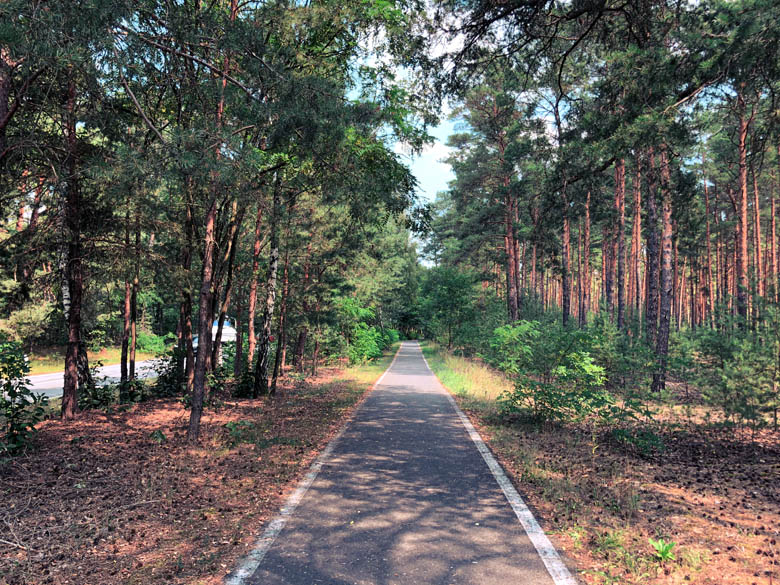
in Germany.
In most cases, there’ll only be one cycling path next to the highway. If that’s the case, you’re allowed to cycle in both directions on the same bike lane. Just be mindful of giving way and keeping to your right for oncoming cyclists.
16. Turning Rules For Cycling in Germany
You can probably skip this part if you’re familiar with cycling in Europe. But for those like us who are new to the bike life, it may not be obvious how to cross the road and turn into a perpendicular street.
So here’s some quick tips on how to takes turns when cycling in Germany.
Turning Right
Turning right is easy enough. The first thing you do is give a hand signal to indicate that you’re intending to turn right. Indicate by lifting your right arm to point right.
Before turning right into the perpendicular road, be on the look out for pedestrians because they have priority and the right of way. In that case, you’ll need to stop and allow people to cross before continuing.
Traffic Fine for not giving pedestrians priority when the traffic light for pedestrians is green: €80 (or a 1 point deduction from your driver’s licence)
Turning Left
Turning left is a little bit trickier, but completely manageable once you get the hang of it.
Again, you’ll need to first indicate with a hand signal that you’re intending to turn left. Simply lift your left arm and point left.
You’ll then need to cycle across the street first before turning left. The cycling pros usually cross the road, check their left blind spot and then turn left.
But to be on the safer side, we’d recommend cycling across the road, give the hand signal for turning left, then gentle swerve towards the right so you can turn left and stop in the bike lane. Then all you got to do is wait for the green traffic light to continue on your merry way.
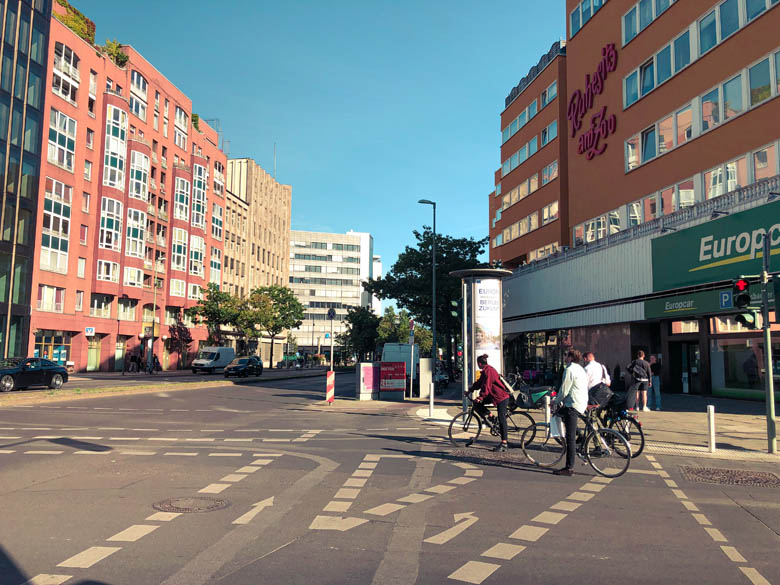
At times you will have to ride across pedestrian crosswalks to turn left. As a responsible cyclist, try your best to keep to the side, cycle slowly and always give pedestrians priority.
Hand Signal for Stopping
Make sure you indicate if you’re making an unexpected stop. The hand signal for stopping is to extend one arm downwards like you’re giving someone behind you a high-five.
17. Cycling on the Pavement
Cycling on the pavement is generally only allowed if there’s an obstruction in the bicycle lane and it’s not safe to cycle on the road. In this case, you’re allowed to cycle on the pavement. But make sure you cycle slowly and carefully because pedestrians should always be given priority.
To be extra safe, rather hop off your bike and push it on the pavement
Traffic Fine for cycling on the pavement or sidewalk: €55 (can be increased depending on the offence and excludes children up to the age of 12).
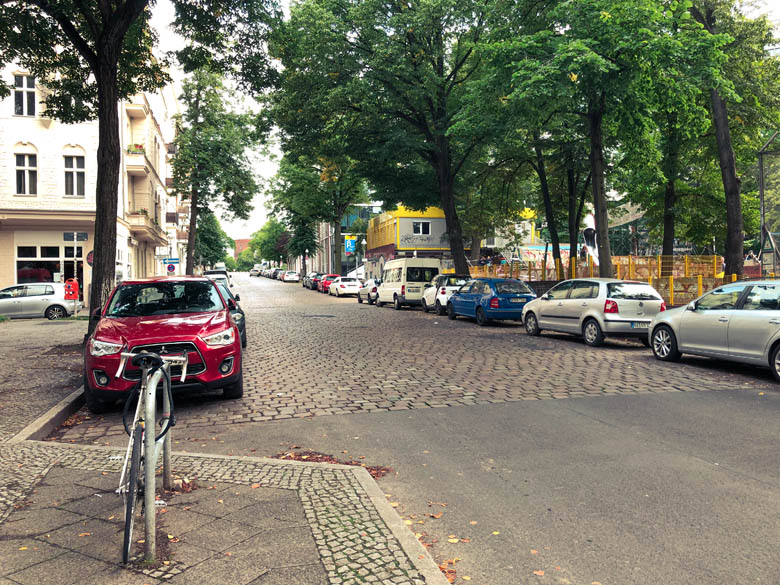
German Road Signs for Cycling
These are some of the most common traffic signs and road markings you’ll need to know for cycling in Germany:
18. Blue Round Bicycle Sign
One of the most important signs to understand to ride a bike in Germany: the white bicycle sign against a blue background. And there are 3 types.
The first one is simple. It only has a white bicycle on it and indicates that cyclists must use the dedicated bike lanes. The only time you’re allowed to cycle temporarily on the road is when there are obstacles in the bike path. And if it’s not possible to cycle on the road safely, you’ll need to get off your bike and push it on the pavement.
If this blue bicycle sign is not shown, then the bike road rule is that you can cycle on the bicycle path or on the road. It’s totally up to you.
The second traffic sign is a blue circle divided by a horizontal white line, with pedestrians on the top and a bicycle on the bottom half. This sign indicates that this is a shared path for both pedestrians and cyclists.
You’ll usually find it on pavements or pedestrian zones. But you’ll still need to show consideration to walking pedestrians (that’s why the sign shows pedestrians on top of the bicycle). So make sure you slow down and be prepared to give way.
The last road sign is a blue circle divided by a vertical white line, with a bicycle on the left and pedestrians on the right. This traffic sign simply indicates that the bike path is next to the pavement and that cyclists should use it.
You’ll normally see this sign when the cycling path is an extension of the pavement and not separated by a kerb. The bike path will have a different brick colour and/or pattern to the pavement, which may sometimes not be as obvious if you’re not paying attention. Hence the need for this sign.
19. White Bicycle Frei Sign
The white bicycle ‘frei’ (or free in English) sign can be a bit confusing. Does it mean that it’s a bicycle free zone (i.e. no bikes allowed)? Or that bicycles are free to cycle here?
Well, it turns out that this sign means that cyclists are free to cycle on usually prohibited surfaces like the pavement or pedestrian zones.
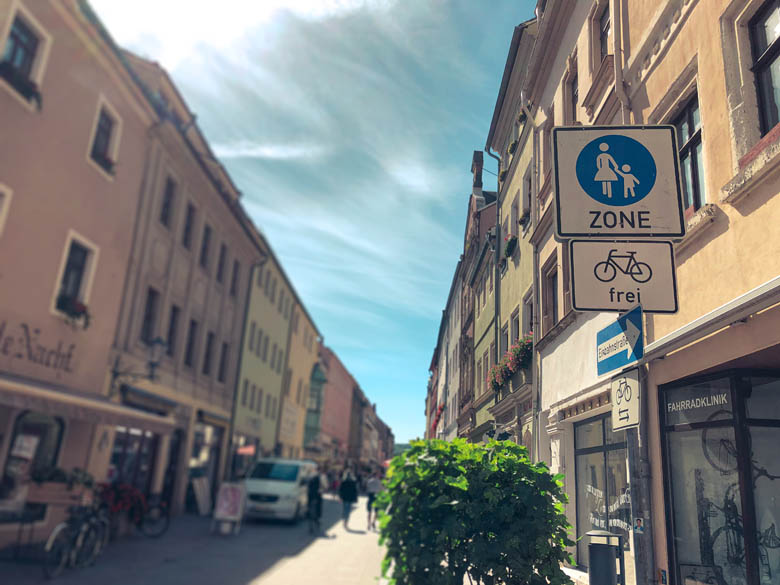
You’ll normally see this sign on the pavement when the roads are made of pebbles or rocks, which make it hard (and painful) for cycling. Or in pedestrian-only zones where there are no other routes for cyclists to get through.
Otherwise, if the bicycle ‘frei’ sign is not shown. You’ll need to hop off your bike and push it.
Are cyclists allowed to ride in a one-way street against the direction of travel?
This is a frequently asked question when cycling in Germany. You’re only allowed to ride a bike in Germany in the opposite direction in one-way streets if this white bicycle ‘frei’ sign is displayed. Otherwise, it’s a no-no.
20. Yellow Priority Sign
You’ll normally see the yellow priority sign attached to the side of traffic lights along main roads. This road sign indicates that other drivers or cyclists have to give you priority and right of way.
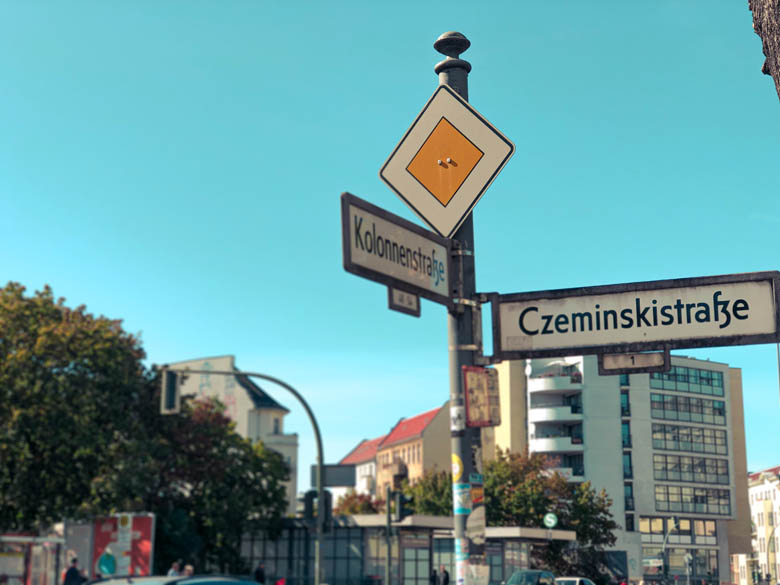
21. Red Inverted Triangle
The red inverted triangle works like a stop sign. It simply means that you’ll need to give priority or right of way to other vehicles and wait.
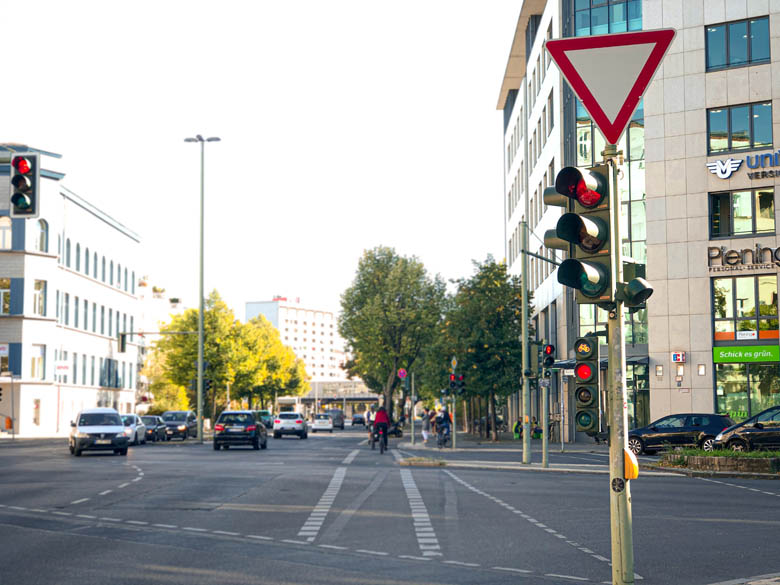
22. Red Circle Road Sign
There are two types of red circle traffic signs that you should understand if you’re cycling in Germany. The first one is a red circle sign with a bicycle. This means that cycling is not allowed in this area.
The second one is a red circle sign with a white centre. This sign means that all vehicles (including bicycles) are prohibited from entering the area.
23. Cycling Lane Lines
Did you know that the different types of cycling lane lines also indicate specific bike road rules? Don’t worry, we didn’t either.
A solid white line indicates that this is a mandatory bicycle lane and that cars are prohibited from driving in this lane at all times. This also means that for cyclists in Germany, you’ll have to ride your bike on the cycling path.
A broken (or dashed) white line on the road means that it’s an optional protection lane. As cyclists, you’ll still need to ride in the bicycle lane. But you’ll need to be more aware of surrounding traffic as cars may drive over the bike path to turn, park or avoiding oncoming traffic.
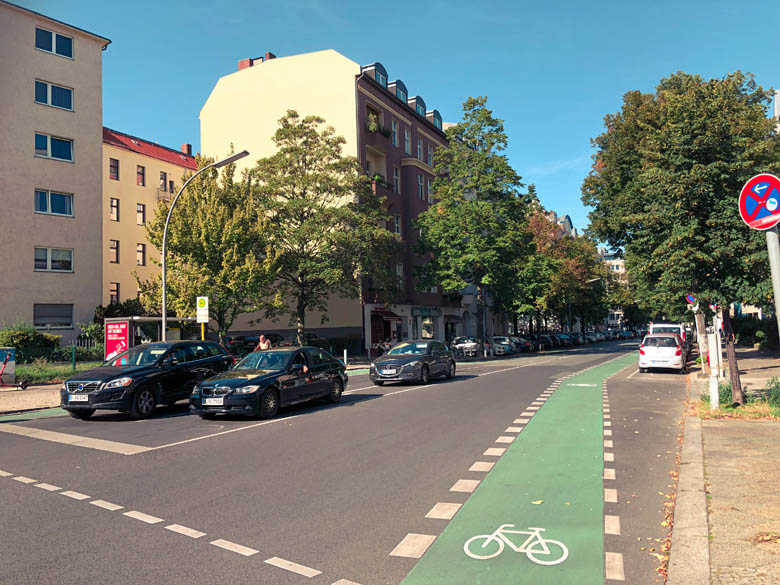
On main roads and intersections, you’ll often see the bicycle lanes painted red or green. Green bike paths mean that cyclists have right of way and can continue without stopping.
Red cycling lanes indicate to cyclists that cars may drive over the bike lane and that you should be aware of oncoming traffic.
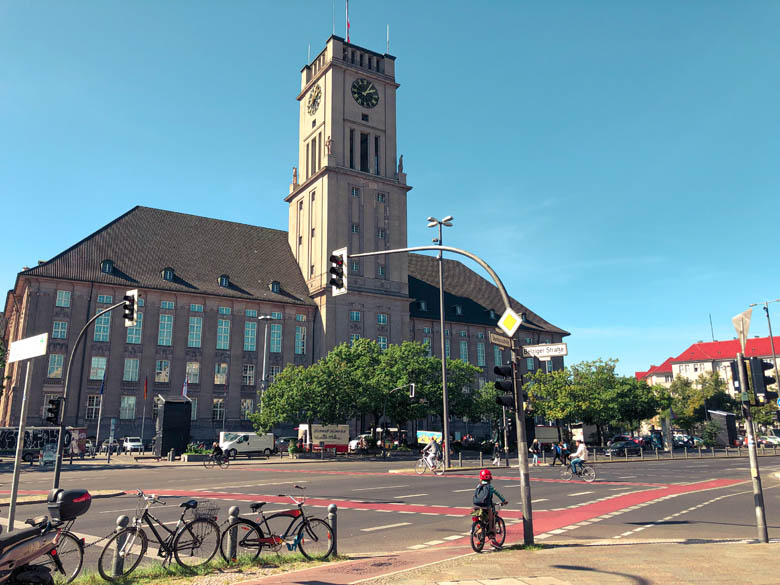
24. Traffic Lights for Cyclists
In Germany, you’ll usually find dedicated traffic lights for cyclists on mandatory bike lanes. Cyclists should always follow these bike traffic lights if they’re available. If not, you should follow the instruction of the general traffic lights for all vehicles.
Traffic Fine for running a red light when cycling in Germany:
€60 – €180 (depending on the severity, you may also lose points on your driver’s licence, ouch!)
Other Tips For Cycling in Germany
Be extra careful when cycling around large vehicles like buses, trucks and lorries. Always stay behind large vehicles and a safe cycling distance away. Never cycle next to, in front or immediately behind large vehicles in blind spots where they can’t see you.
If you’re still learning how to ride a bike in Germany, always cycle more defensively. You can cycle slowly if you stick to the right and let other cyclists pass you.
Wear light-coloured or reflective clothing when cycling at night.
Don’t cycle when it’s raining. It’s not illegal or prohibited, but it does increase the risk of accidents. Rather wait it out, or take your bike on the train. Remember to buy a bike ticket and enter train carriages with a bicycle sign.
What To Do In The Event of An Accident
Touchwood! We hope this doesn’t happen to you, but accidents do just happen whether we want it or not. If you’re involved in an accident when cycling in Germany, you should call the number for emergency services by dialling 112.
You’ll be able to call this number even if you don’t have credit or airtime on your phone. If you can’t call, ask someone to help. There are lots of good samaritans in Berlin that will help you.
Make sure to also get the full name and contact number for the other person involved in the accident. They should have liability insurance too which should cover damages done to you or your bike.
For more serious accidents where you or someone else is in danger, call the police at 110. And remember to never leave the scene of the accident without reporting to the police. It’s actually an offence to do so.
In some cases, you may need a lawyer to help you claim damages if the other person is denying responsibility. That’s why it’s always useful to have legal insurance in Germany.
Legal insurance will not only give you protection when you’re in a bicycle accident or receive unjustified parking fines. But it will also give you legal cover and advice on your rental and employment contracts.
Frequently Asked Questions (FAQ)
Yes – you could get a traffic fine for risking the safety of others and your own. Always cycle with both hands on the handlebar.
It depends. Most bike lanes in Germany (usually the narrow ones) are one way only. There are some wider bike lanes that are meant for two way traffic. You can usually tell the difference by the road markings on the bicycle lane indicating arrows in both directions.
No – you’re not allowed to ride a bike on the sidewalk in Germany. The only exception is if there’s an obstruction in the bicycle lane and it’s not safe to cycle on the road.
According to the European Cyclists’ Federation, the minimum distance between cyclists is 1.5 meters in towns and city centers, and 2 meters outside the city limits.
You can take your bicycles aboard the S-Bahn, U-Bahn and regional trains (with a bike ticket). But bicycles are not allowed on any buses in Germany.
No – it’s illegal to cycle on the autobahn, highways or any high-speed motor roads in Germany.
No – Germany has no official law that requires cyclist to wear bicycle helmets. It’s all up to the discretion of the cyclist. The only time that helmets are mandatory is if your bicycle has a motor and can ride at speeds faster than 25km/h.
No – you are allowed to wear headphones when cycling in Germany as long as you can still hear surrounding traffic.
No – you do not need a bicycle license to ride a traditional bike in Germany. You only need a license for bicycles that have a motor (more than 250 watts).
Summary of German Bicycle Rules
We hope you found the bike road rules and German road sign explanations useful and that it will help you ride a bike in Germany more confidently!
For more road safety information, check the German Road Safety or ADAC website.
Make sure you read our self-guided Berlin Wall Tour by Bike and Best Outdoor Places in Berlin guide (including Liepnitzsee and Tonsee) for a list of bike-friendly routes to cycle.
These German laws and traffic rules may be a lot to digest, but you’ll get the hang of it the more you cycle around Germany. Here’s a short summary if you ever need a quick reminder.
Save Me For Later
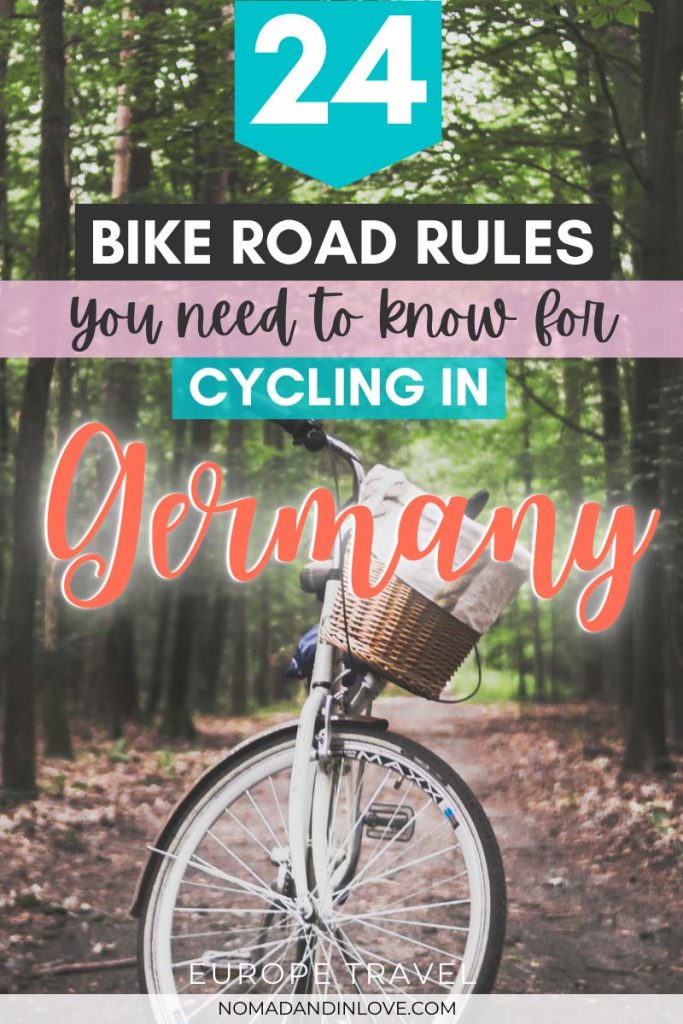
DO Follow Rules When Cycling in Germany
- Check that all the required items on your bike are working.
- Cycle in the bicycle lane and when that is unavailable, on the road as close to the right side as possible.
- Obey the bicycle traffic lights and if there aren’t any, yield before crossing intersections.
- Keep to the right side of the bicycle lane and only move to the left when overtaking (i.e. ride in a single file).
- Use arm signals to indicate before turning left or right: point left with your left arm or point right with your right arm before turning.
- When making an unexpected stop, extend one arm downwards like you’re giving someone behind you a high-five
DON’T Follow Rules When Cycling in Germany
- Don’t use your cellphone while cycling (use a cellphone holder if you need GPS).
- Don’t drink or be under the influence and cycle.
- Never ride a bike on the Autobahn (Germany’s high-speed highway) or any motorway. It’s illegal.
- Don’t cycle on the pavement unless road signs indicate otherwise.
